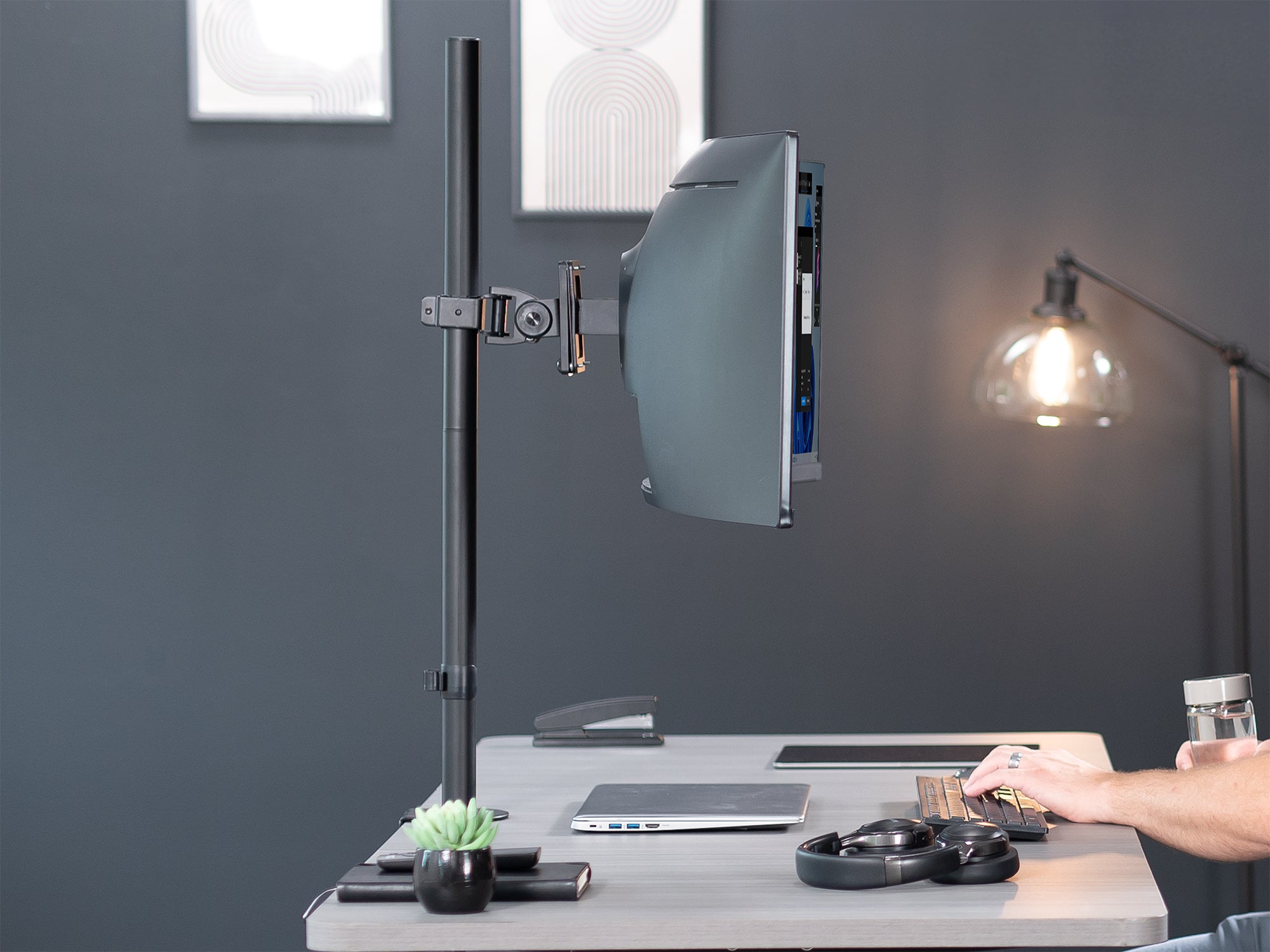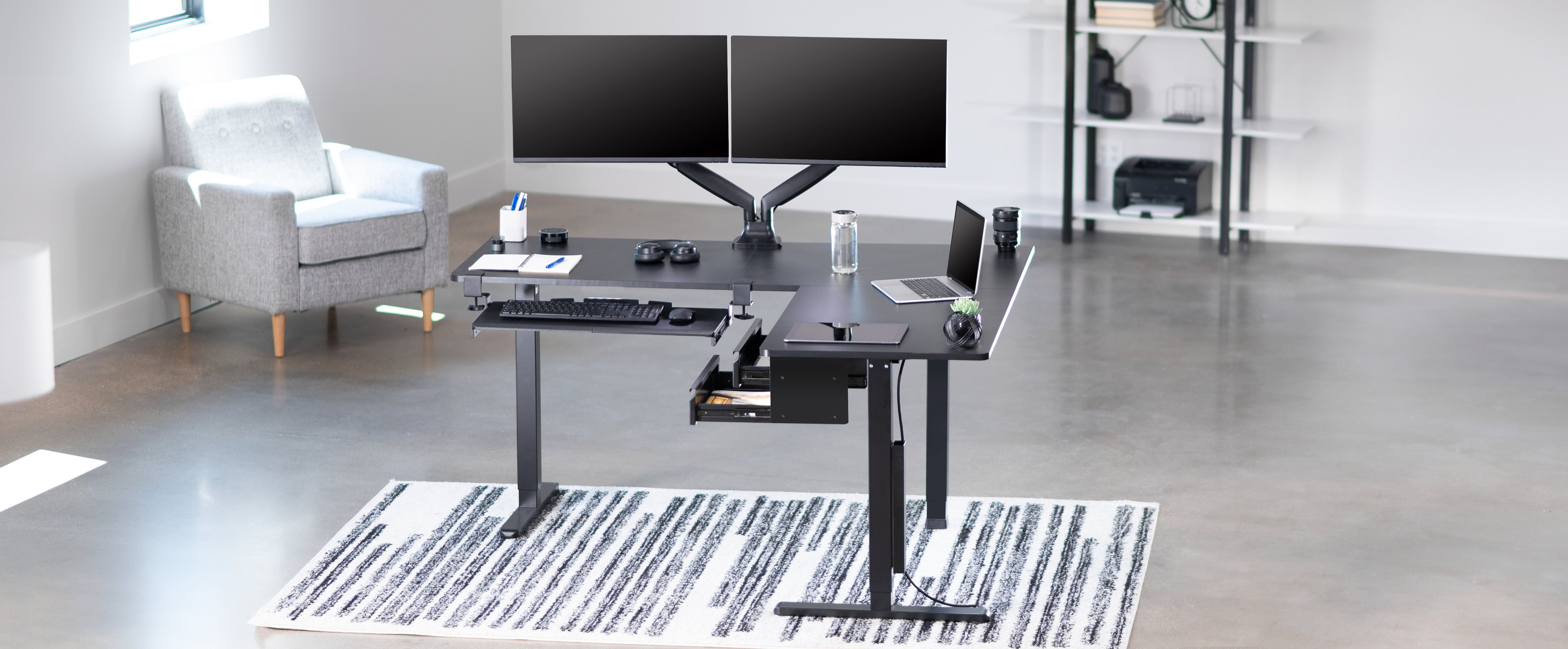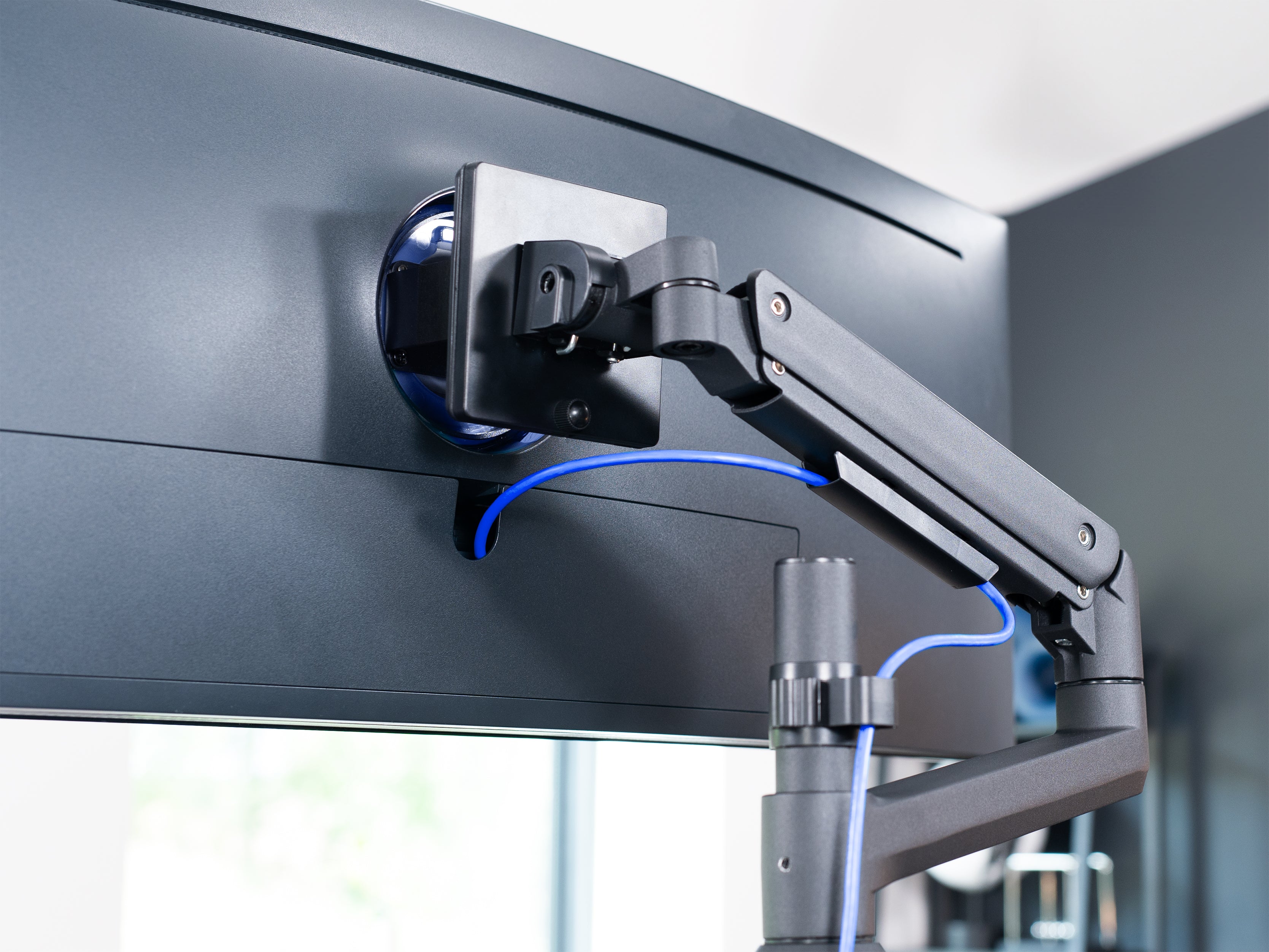Are you tired of balancing your monitor atop a stack of books so you can view it at just the right angle? Do you find yourself scratching your head in bewilderment at terms like “VESA 100x100” and “counterbalance gas spring arm”? Are you looking to replace your stock monitor stand, but don’t know where to start? If so, this guide is for you.
There’s more monitor stand options available today than ever before, with each variation having a different application and unique set of features. While this seemingly infinite number of options does mean that you can get the exact stand that fits your specific needs, it can also can be a bit overwhelming. That’s why we’ve compiled this guide, with everything you need to consider and check before committing to a specific monitor stand purchase.
We’ll be going over how and what to consider when buying a new monitor stand, including compatibility, mounting type, articulation, and special niche features. Without further ado, let’s dive in!
Monitor compatibility
The first thing you need to consider is whether a stand is compatible with the monitor(s) you want to use it with.
Every monitor stand has different screen size and weight limits that need to be adhered to. Making sure your monitor does not exceed these limits is very important! The stability and lifespan of your monitor and stand depend on it.

If you’re using multiple monitors, you can either purchase multiple monitor stands, or you can get a stand that will accommodate the number of screens you’re using. For most desk setups, mounting all your monitors to one stand will be the most economical and space efficient solution.
Most monitor stands available today use VESA standards, so the stand will fit the majority of monitors on the market. Some monitors and stands have different VESA patterns, so you should do your research and be extra certain your monitor and the stand you’re buying are compatible.
But what if your monitor doesn’t use VESA? Some monitors have specialized mounting systems, designed to be used with only a select few monitor stands. If this is the case with your monitor, don’t panic! There are VESA adapters available for all kinds of monitor mounting systems, and some adapters work on all kinds of different monitors.
To sum up:
- Make sure your chosen monitor stand fits your monitor, keeping in mind the screen size and weight limits
- Make sure your chosen monitor stand accommodates the number of monitors you want to mount to it
- Make sure your chosen monitor stand has the correct VESA pattern, or buy a compatible adapter
Mounting type
So far we’ve covered mounting your monitor to the stand. For this section, we’ll be looking at how the stand integrates into your workspace. There are several different monitor stand mounting types, and we’ll be looking at the pros and cons of each of them.
Freestanding: A monitor stand with a freestanding base is the simplest option, only needing to be set on your desk or other work surface.
No drilling or other complicated installation procedures are needed with this type of stand, and the fact that it’s not attached to your desk means your monitor can move around your workspace as needed.
This simplicity and versatility come at the price of stability and efficiency though. Because the stand is not attached to anything, it can be moved accidentally or even knocked over if not careful. This is instability mitigated by having the bases be large and weighty, but that means less desk space for you.
Clamp mount: Clamp mounts are a great balance between simplicity and stability. Like the freestanding base, it doesn’t require any drilling or stud-finding, just clamp to your desk and you’re ready to go.
Being clamped down means you can’t easily move your monitor from place to place, but for most desk setups that works just fine. The clamp design also means the stand has to placed on the edge of the work surface, which might not work for some setups.
Both the clamp mount and freestanding base options are great if you’re using a space you can’t modify permanently, like a temporary office or rented space.
Grommet mount: Grommet mounts carry all the same advantages and disadvantages of the clamp mount, the only difference being that they require a pre-drilled hole in the work surface you want to mount it to. Securing through a grommet hole adds a little extra stability to the stand.
Wall mounts: Wall mounts are extremely stable and save a lot of space, but they’re a bit more difficult to install, and a pain to move if necessary. Wall mounts are great for if you need your monitor somewhere with no work surface in front of it or are just extremely committed to a specific desk setup and the efficiency it provides is worth the lack of versatility.

There are other offshoots and specialty mounts out there, but these what make up the majority of monitor stands on the market today. Make sure to choose the mounting type that works best for your workspace, and prioritize what’s most important for your workflow. Versatility might make more of an impact on your desk’s efficiency than space, or vice versa.
To sum up:
- Freestanding bases are the most versatile and easy to setup, but the least stable and space efficient
- Desk clamps and grommet mounts are a balance between space efficiency and stability
- Wall mounts are the most stable and space efficient but are the least versatile and the hardest to set up
- Make sure to choose the mounting type that works best for your workflow
Articulation
The next thing to keep in mind is monitor articulation. This is what allows you to adjust the monitor further after installing it to the stand.
Stationary: Stationary monitor stands don’t articulate at all. This adds a little extra stability, but it also means you have to move the entire monitor stand if you want to change your viewing angle.
Height adjustment: Most monitor stands allow some form of height adjustment, so you can set your screen at the most ergonomic position for you. Some have an additional mechanism to allow you to adjust the height on the fly, which is great for a workstation that’s shared by people of varying heights.
Head adjustment: Most monitor stands you can buy today offer head adjustment, which lets you change the swivel, tilt, and/or rotation of your monitor to varying degrees. It is also common to be able to adjust the tension of these adjustments, so you don’t have to sacrifice stability for this added versatility.

Articulating arms: Sometimes you need your monitor to be more mobile within your workspace. An articulating arm gives your monitor full horizontal mobility, allowing it be positioned anywhere around the desk. Each joint has its own tension adjustment, so you can choose want easy versatility or maximized stability.
Gas spring: A counterbalance gas spring arm lets you adjust the tension to match the weight of the monitor, so it can be easily moved or left in any position within the arm’s reach. When properly set up, a gas spring arm has most of the same advantages of a standard articulating arm, except it can be adjusted to much faster and allows both horizontal and vertical movement. Unlike articulating arms though, it can’t tighten down at a specific position.
When considering the articulation of a monitor stand, keep in mind how you want to set it up on your desk and what all you use your monitor for. Just because a stand has more adjustability, doesn’t mean it’s adjustable in a way that is helpful for your specific setup.
Niche monitor stands solutions
What we’ve discussed so far are standard monitor stand solutions, but there are a lot of monitor stands for far more specific situations.
Standing mounts: A simple way to make your desk setup more ergonomically friendly, standing mounts let you turn your normal desk into a standing desk. Some stands use gas spring arms or other mechanics to easily switch between sitting and standing, letting you stay active all day!
Trays: Some monitor stands have additional trays attached to hold a keyboard or laptop. This is great is your laptop plays double duty as your desktop, or if you just need a little extra space in your work area.
USB ports: Having USB ports built directly into your monitor stand is remarkably convenient. Not having to go searching under your desk every time you want to plug something in is a great timesaver, and being able to plug in your keyboard and mouse from your desktop can make cable management a breeze.

Other niche stands: You can get a monitor stand designed specifically for widescreen monitors, a stand with stylish tempered glass base, or even one that conveniently mounts to a cubicle wall!
The point is, you can look for a stand that satisfies your specific needs. There’s a lot of great stands out there! Don’t be afraid to look.
So that’s all the main points to consider when deciding which monitor stand to buy. To summarize everything covered in this guide, here’s a quick cheat sheet:
When buying a new monitor stand, remember to:
- Make sure your monitor is compatible with the stand
- Choose the appropriate kind of stand mount for your desk space and workflow
- Get a stand that offers the right amount of articulation for you
- Look for solutions to fit your specific needs
Every workspace is unique and has different needs. Yours is no different. Now that you know the different solutions that are out there, you can go find the one that works best for you!
If you would like to keep up-to-date with our latest blog posts and product launches, be sure to follow us on our social media pages.




Share:
5 Ergonomic Workstation Hacks
4 Tips for the Perfect Desk Setup on a Budget